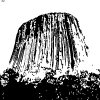
A detailed outline of the Geology vertical has been completed.
Introduction to Our Geology Course
Geology is a young science that studies very old things. It began more than two centuries ago when James Hutton hiked around his native Scotland while looking at odd rock formations and wondering how they came to be that way. It reached maturity only about fifty years ago, when the theory of plate tectonics integrated and explained an enormous range of facts that had been discovered about Earth and its history.
There is always a time lag between a crucial new scientific theory and when it is adopted as part of the school curriculum. But fifty years is long enough. Geology is prerequisite for understanding evolutionary biology and climatology, both of which are already taught (inadequately, but to some extent). It is time for high schools to recognize the importance of this science and offer a full course, rather than merely a few random snippets.
Hutton once said that “the present is the key to the past,” meaning that we must infer the past from what we can observe in the present. Geology is replete with wonderful examples of how scientists make such inferences, and these examples provide a student with deep insight into the discovery process. Equally important, however, is what geologists have discovered; if we turn Hutton’s statement around and play it forward, we can say that understanding the past is one key to creating a better future. This is the value of studying history, both natural and human.
The theory of plate tectonics represents an extraordinary integration of geography, stratigraphy, chemistry, nuclear and thermal physics, and evolutionary biology. The story of Earth that emerges from the theory is fascinating, and understanding it is crucial to mankind’s future well-being on this beautiful and ever-changing planet.
